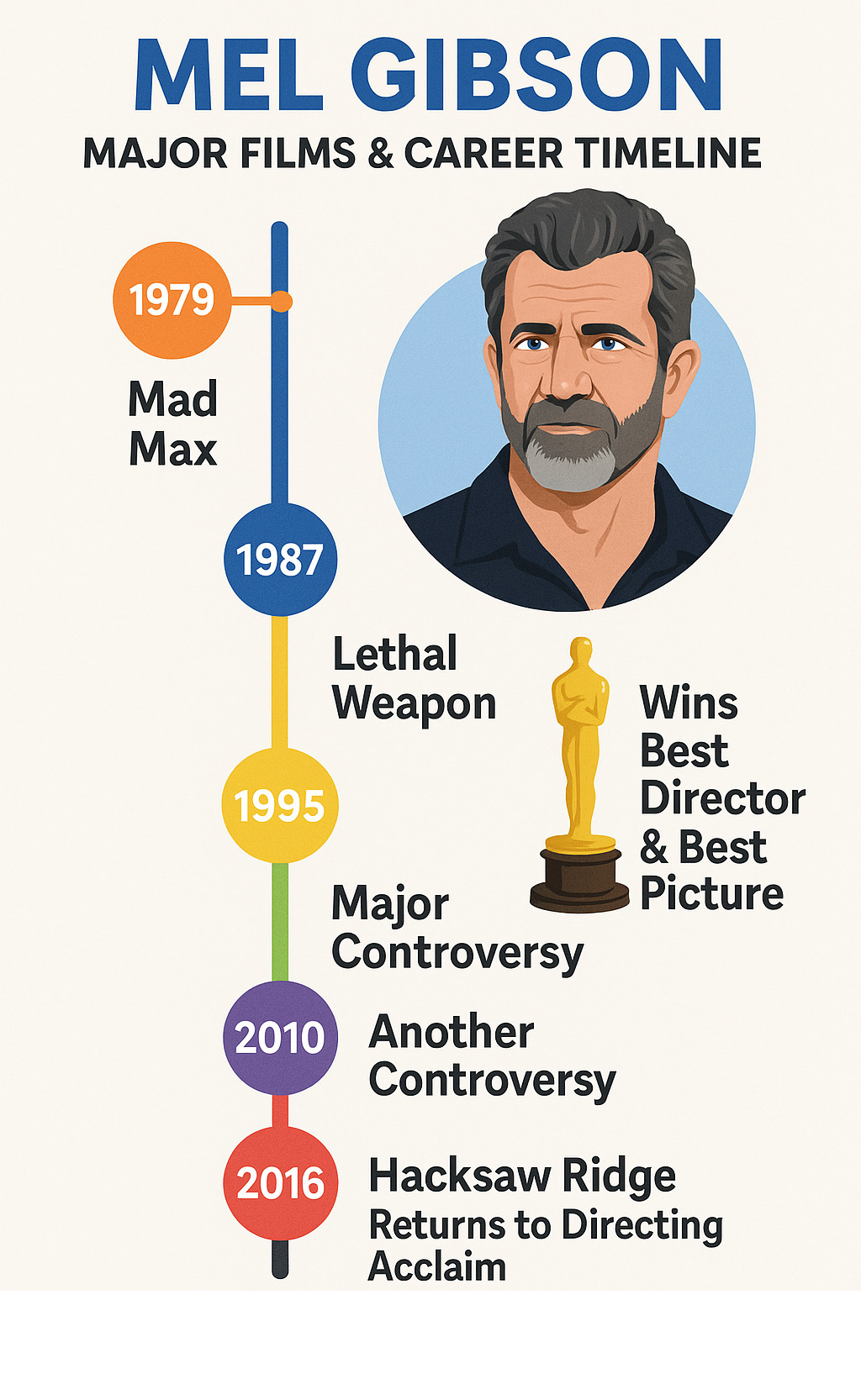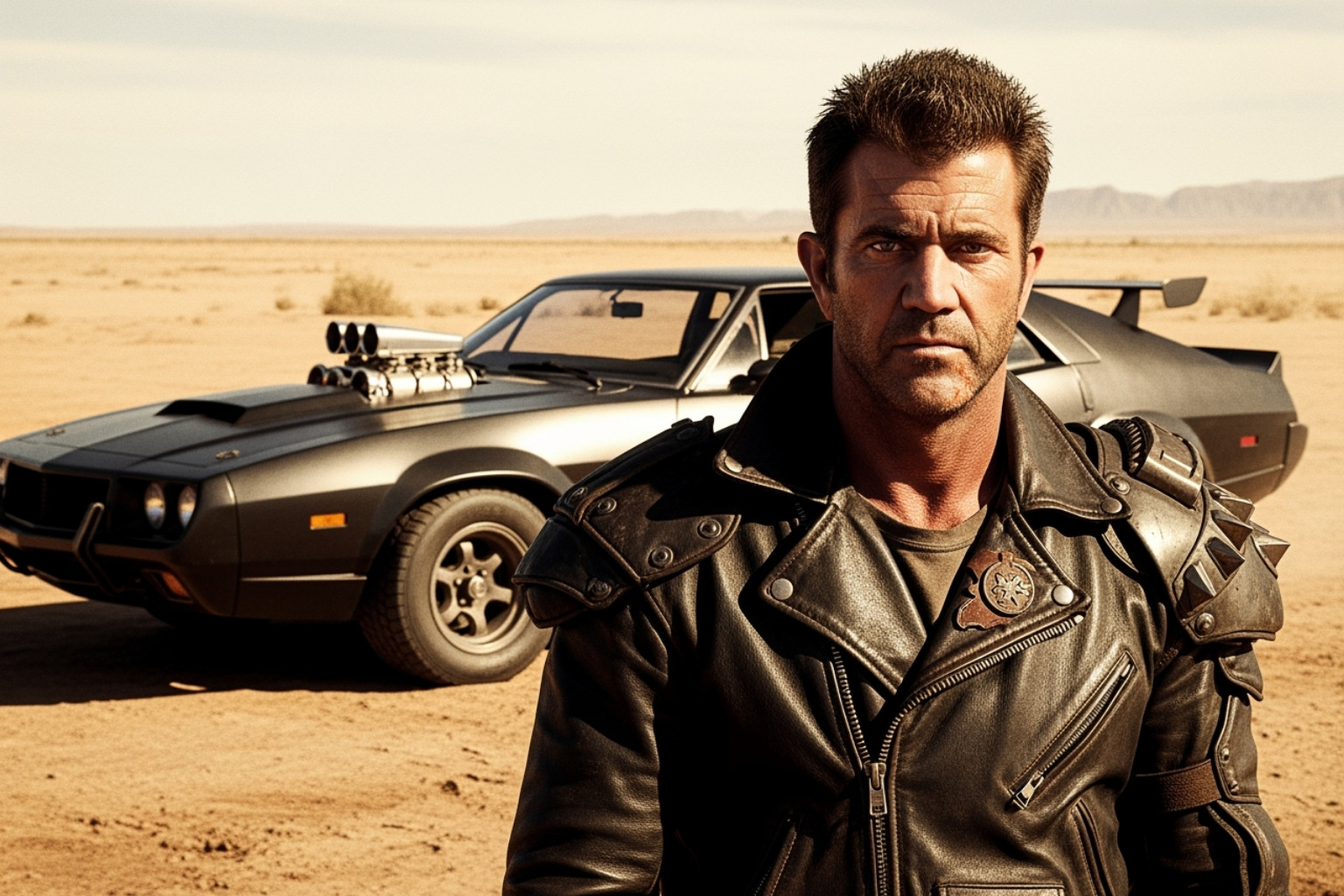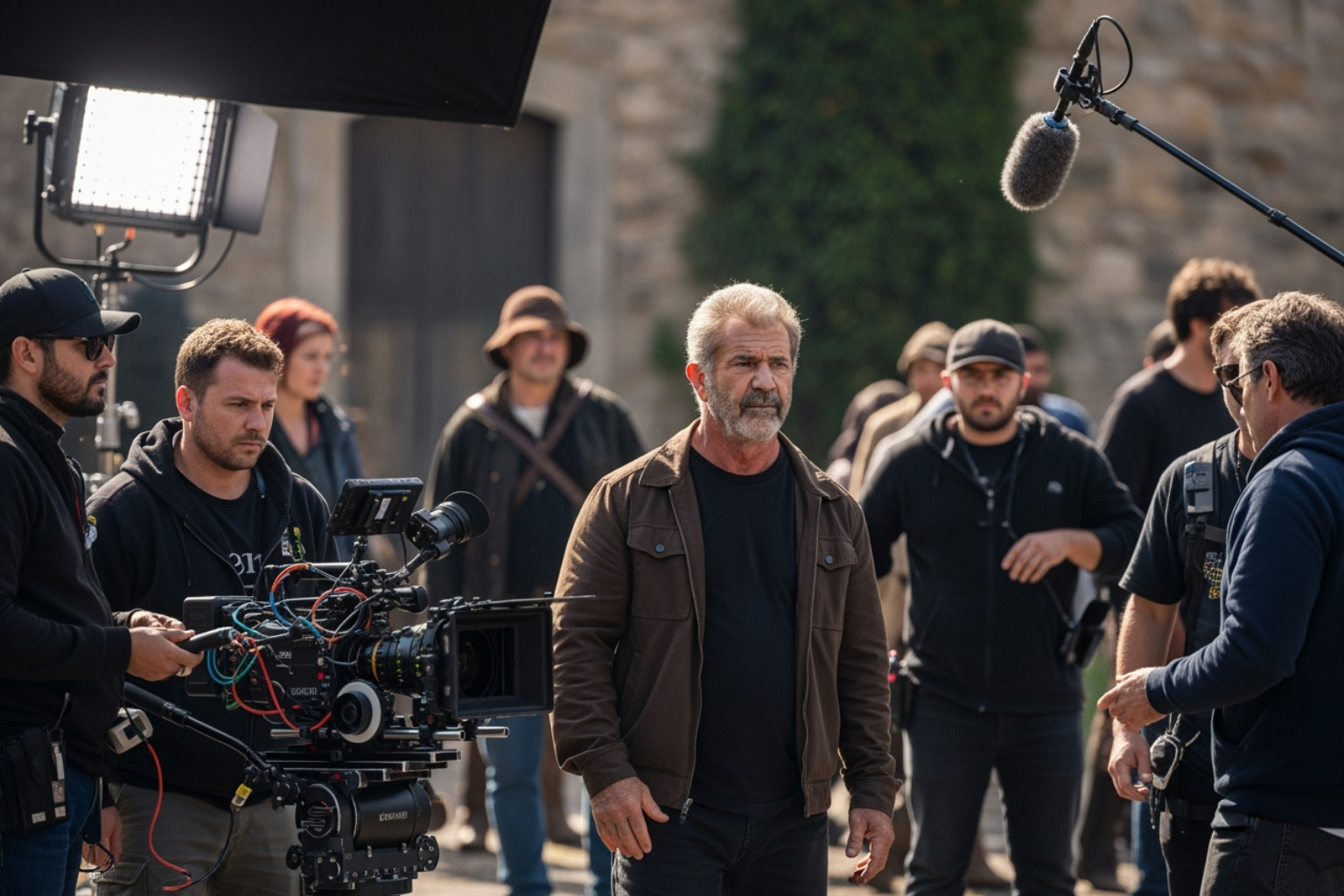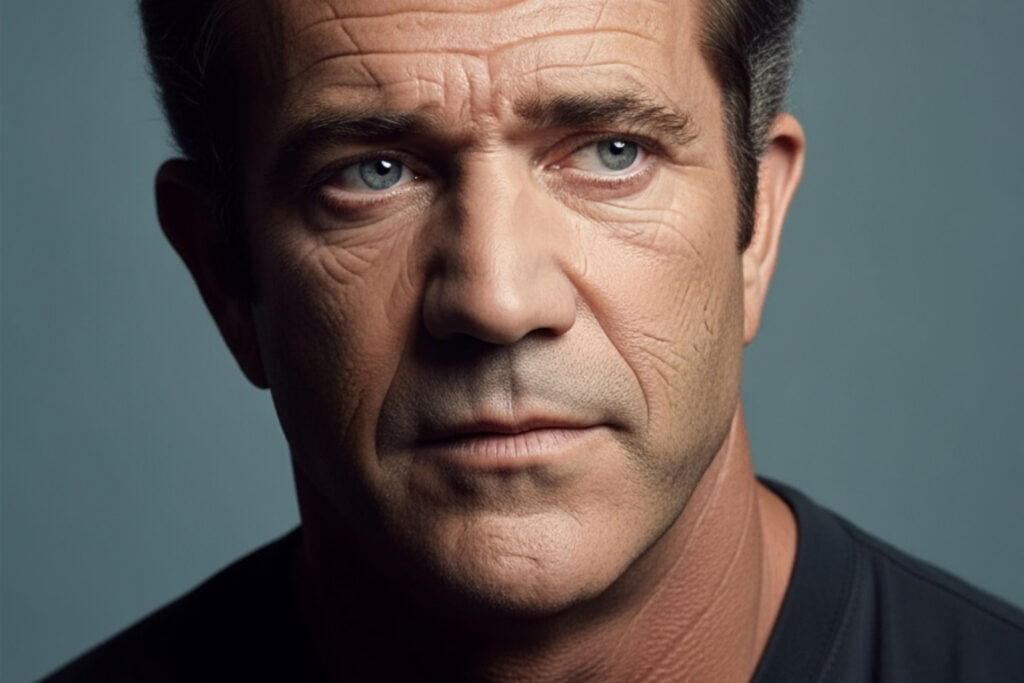Why Mel Gibson Remains One of Hollywood’s Most Complex Figures
Mel Gibson is an American actor and director whose career spans four decades of triumph, controversy, and redemption. Born January 3, 1956, in Peekskill, New York, Gibson became one of Hollywood’s biggest stars through iconic action roles before transitioning into an Academy Award-winning director.
Quick Facts About Mel Gibson:
- Net Worth: Approx. $425 million
- Major Acting Roles: Mad Max, Lethal Weapon series, Braveheart
- Directing Achievements: 2 Oscars for Braveheart (Best Picture, Best Director)
- Career Span: 1976 to present
- Controversies: 2006 DUI arrest, 2010 domestic disputes, industry blacklisting
- Comeback: Hacksaw Ridge (2016) earned a Best Director Oscar nomination
- Personal Life: 9 children, traditionalist Catholic faith
His journey from action hero to acclaimed filmmaker reads like a Hollywood script. After his breakout role in Mad Max made him an international star, he became People magazine’s first “Sexiest Man Alive” in 1985. His transition behind the camera proved equally successful, with Braveheart earning him dual Oscars and The Passion of the Christ becoming a box office phenomenon.
Yet Gibson’s story is far from straightforward. The same man who created Oscar-winning epics also faced a decade-long industry exile following personal controversies. His career arc, a true “rise and fall and rise story,” reveals fascinating layers most people never see.

Relevant articles related to mel gibson:
From New York to International Stardom: The Making of an Unlikely Icon
Though known as an Australian action hero, Mel Gibson‘s story begins in New York. His journey to stardom is full of unexpected twists that shaped one of Hollywood’s most fascinating careers.
Early Life and Roots
Mel Gibson was born Mel Columcille Gerard Gibson on January 3, 1956, in Peekskill, New York. The sixth of eleven children, his life changed dramatically at age 12.
His father, Hutton Gibson, won money on Jeopardy! and received a $145,000 work injury settlement. In 1968, he moved the family to Sydney, Australia, partly to prevent his eldest son from being drafted into the Vietnam War.
This move became the foundation of Mel Gibson’s future. He initially considered becoming a chef or journalist, but his sister encouraged him to try acting. He enrolled at the National Institute of Dramatic Art (NIDA) in Sydney, studying alongside future stars like Judy Davis. His early stage work showed his range, playing roles like Romeo and Queen Titania.
His film career began with a small role in Summer City (1977), but his performance in the drama Tim (1979) earned him an Australian Film Institute award for Best Actor.
Breakthrough to Fame

The year 1979 changed everything. While Tim showed his dramatic talent, the low-budget thriller Mad Max launched him into international stardom. He earned just $15,000 for the role, a small sum that transformed his life. The raw intensity Mel Gibson brought to Max Rockatansky led to two sequels, with Gibson earning his first million-dollar salary for Mad Max Beyond Thunderdome (1985).
He wasn’t just an action hero. His performance in Peter Weir’s war drama Gallipoli (1981) proved his dramatic skill. By the mid-1980s, Mel Gibson was Hollywood royalty. His role as Martin Riggs in Lethal Weapon (1987) created a memorable character and launched a beloved franchise.
In 1985, People magazine named him their first “Sexiest Man Alive,” cementing his status as a cultural icon. The financial rewards matched his fame; Gibson commanded $25 million for Lethal Weapon 4 (1998), a salary he matched for later films like The Patriot (2000) and Signs (2002).
The Director’s Chair: Vision, Faith, and Awards
While Mel Gibson captivated audiences as an actor, his true passion was storytelling from behind the camera. He once explained, “I like directing much better… It’s essentially the same job, which is storytelling, but you have more control.” This desire for control led him to create some of cinema’s most ambitious and controversial films.
The Success of a Historical Epic
Mel Gibson first directed The Man Without a Face (1993), a touching drama that showed his skill with character stories. But his second directorial effort, Braveheart (1995), changed everything. He initially only wanted to direct, but producers insisted he also star as William Wallace. The compromise was gold.
The historical epic became Mel Gibson’s masterpiece, winning five Academy Awards, including Best Picture and Best Director. He joined the exclusive club of actors who have won the Best Director Oscar, a rare Hollywood achievement.

Braveheart showcased Gibson’s talent for grand storytelling, with sweeping battle scenes and emotional depth. The film’s success proved that Mel Gibson was a serious filmmaker with a unique vision.
Ambitious Projects and Controversy
After Braveheart, Mel Gibson began his most personal project, The Passion of the Christ (2004). The film, rooted in his traditionalist Catholic faith, depicted Jesus’s final hours. Gibson self-financed it for $25 million and shot it in Aramaic, Latin, and Hebrew, a move Hollywood insiders considered risky.
They were wrong. The Passion of the Christ became a cultural phenomenon, earning over $370 million in the U.S. and becoming the highest-grossing R-rated film of its time. The film’s success showed Mel Gibson’s ability to connect with audiences on a profound level.
However, the film sparked intense controversy over accusations of antisemitism and graphic violence. Mel Gibson defended his work, stating, “Jesus died for the sins of all times, and I’ll be the first on the line for culpability.”
Undeterred, he directed Apocalypto (2006), set during the Mayan empire’s decline and filmed in Yucatec Maya. This ambitious project further established his reputation for immersive historical filmmaking.
The Fall: Understanding the Controversies
The early 2000s brought a dramatic shift in Mel Gibson‘s story, as personal struggles became painfully public and derailed his career. After years of success, he found himself exiled from the industry that made him a star.
The 2006 Incident
The first major crack in his public image came in July 2006. Mel Gibson was arrested for a DUI in Malibu, but it was his behavior during the arrest that caused the scandal. He made antisemitic remarks to the arresting officer that quickly became front-page news.
The incident sent shockwaves through Hollywood. The remarks were especially damaging given the earlier controversies surrounding The Passion of the Christ. Mel Gibson quickly apologized, admitting he had “acted like a person completely out of control” and spoke of his lifelong battle with alcoholism. He pleaded no contest to the charge, receiving probation and a fine.
This wasn’t his first DUI; he was banned from driving in Ontario in 1984 for a similar offense. This time, however, the consequences were career-altering. Major studios distanced themselves, and his bankability evaporated, leading to what many called a Hollywood “blacklisting.”
The 2010 Scandal
Just as the dust was settling, Mel Gibson faced an even more damaging controversy in 2010. A tumultuous relationship with Oksana Grigorieva led to allegations of domestic violence and damaging leaked audio recordings.
The tapes, containing explicit threats and racial slurs attributed to Gibson, were deeply disturbing and intensified the public backlash. Mel Gibson pleaded no contest to a misdemeanor domestic violence charge in March 2011, receiving probation and counseling.
The scandal had immediate professional consequences. His talent agency dropped him, and he faced widespread condemnation. While his estranged wife of 31 years, Robyn Moore, stated she never experienced abuse from Mel Gibson, the damage to his reputation was profound.
This period forced him into a career hiatus. The man who had once been one of Hollywood’s most bankable stars had become an industry pariah.
The Comeback and Complicated Legacy of Mel Gibson
After nearly a decade in Hollywood’s wilderness, Mel Gibson began the difficult task of rebuilding his career. The road back revealed his remarkable talent and determination.
The Road to Redemption with a War Drama
A 2011 comeback attempt, The Beaver, directed by his friend Jodie Foster, failed at the box office, suggesting audiences weren’t ready for his return. But Mel Gibson persisted, developing Hacksaw Ridge, a biographical war drama that would be his ticket back to respectability. The film, about a WWII conscientious objector who saved 75 men without a weapon, resonated with Gibson’s own themes of faith and redemption.

Hacksaw Ridge became a critical and commercial success. The film earned $164 million worldwide, and critics praised Gibson’s masterful direction. More importantly, it earned him an Academy Award nomination for Best Director, his first Oscar nod in over two decades. The film received six Oscar nominations in total, winning two, and put Mel Gibson back in the conversation as a serious filmmaker.
Personal Beliefs and Lifestyle
To understand Mel Gibson, one must understand his deep religious convictions. He is a traditionalist Catholic whose faith influences his work and life. “There is no salvation for those outside the Church,” he once said, reflecting his conservative stance. Critic Matt Zoller Seitz has called him “the pre-eminent religious filmmaker in the United States.”
Beyond religion, Mel Gibson has never shied away from his political views, often criticizing the establishment. He has also shown a philanthropic side, donating to conservation efforts in Guatemala. His estimated $425 million net worth has funded impressive real estate, including a private island in Fiji and a ranch in Costa Rica.
His personal life has been public, with a large family of nine children. His 2011 divorce from Robyn Moore was one of Hollywood’s most expensive, reportedly costing him over $400 million.
Those who work with Mel Gibson describe a unique sense of humor; he is known for mooning the cast and crew after serious scenes to break the tension. Today, he remains a “gifted and rather complicated performer,” embodying a true “rise and fall and rise story.”
What’s Next? The Future of a Hollywood Survivor
Mel Gibson continues to prove his resilience, with a career that began in 1976 and shows no signs of slowing down. Even after industry exile, he has carved out a space as a seasoned performer and director.
Upcoming Directing Projects
Mel Gibson is set to direct Lethal Weapon 5, a full-circle moment allowing him to bring his directorial vision to the franchise that made him an action star.
Even more ambitious is the long-awaited sequel to his masterpiece, tentatively titled The Passion of the Christ: Resurrection. Given the original film’s massive success and cultural impact, the sequel is guaranteed to be one of the most talked-about films of its time.
These projects prove that Mel Gibson still has significant pull in the industry, able to secure funding for ambitious films despite past scrutiny.
Recent and Future Acting Roles
While his directing generates buzz, Mel Gibson remains active as an actor. He has recently gravitated toward independent films that showcase his rugged intensity, including Father Stu (2022), Confidential Informant (2023), On the Line, Bandit, and Boss Level.
His willingness to accept lighter material, like his role in Daddy’s Home 2 (2017), shows his flexibility and desire to explore new facets of his craft. He is also a busy producer, with 24 producer credits on IMDb, underscoring his commitment to shaping stories from multiple angles.
On a personal note, Gibson recently underwent an impressive health change, losing 14kg in 8 weeks. He joked about the results: “My clothes fit, my back doesn’t hurt anymore, I sleep better.” This dedication suggests he’s preparing for demanding roles and projects ahead.
Frequently Asked Questions about Mel Gibson
People are naturally curious about Mel Gibson and his fascinating career. Here are the answers to the most common questions.
What are Mel Gibson’s most famous movies?
As an actor, Mel Gibson‘s most famous roles are in the Mad Max and Lethal Weapon series, Braveheart (1995), The Patriot (2000), and Signs (2002). As a director, he is renowned for the Oscar-winning Braveheart, the massively successful The Passion of the Christ (2004), the visually stunning Apocalypto (2006), and his comeback film Hacksaw Ridge (2016).
How many Oscars has Mel Gibson won?
Mel Gibson won two Academy Awards for Braveheart in 1995: Best Director and Best Picture. This made him one of the few actors to win the industry’s highest honor for directing. He was later nominated for Best Director again for Hacksaw Ridge (2016), marking his official return to Hollywood’s good graces.
Why was Mel Gibson “cancelled” or blacklisted?
Mel Gibson‘s career was derailed by two major controversies that led to a near decade-long blacklisting from Hollywood. The first was in 2006, when he made widely publicized antisemitic remarks during a DUI arrest. The situation worsened in 2010 when leaked audio tapes revealed him using abusive language and racial slurs during a dispute with his then-girlfriend, Oksana Grigorieva. These incidents led to him being dropped by his agency and shunned by major studios.
Conclusion
Mel Gibson‘s journey through Hollywood is an epic screenplay of triumph, tragedy, and redemption. His story is a study in contrasts: a charismatic star and Oscar-winning director, a man of faith whose personal demons led to public disgrace, and a visionary whose talent often overshadows his controversies.
His rise with the Mad Max and Lethal Weapon franchises and his directorial triumph with Braveheart marked the pinnacle of his career. However, his downfall in the mid-2000s, fueled by public controversies, led to an industry blacklisting that would have ended most careers.
What makes his story compelling is the comeback. Hacksaw Ridge marked his return, proving that genuine talent can overcome daunting obstacles and earning him another Oscar nomination for Best Director. Today, Mel Gibson continues to work, with projects like Lethal Weapon 5 and a sequel to The Passion of the Christ on the horizon.
His journey from the heights of glory to the depths of disgrace and back again remains one of the most complex stories in modern entertainment. His chapter in film history is far from over. Mel Gibson‘s career is a journey of epic proportions, and if you’re ready to start your own trip exploring the world’s most fascinating culinary destinations, check out the guides at The Dining Destination.







